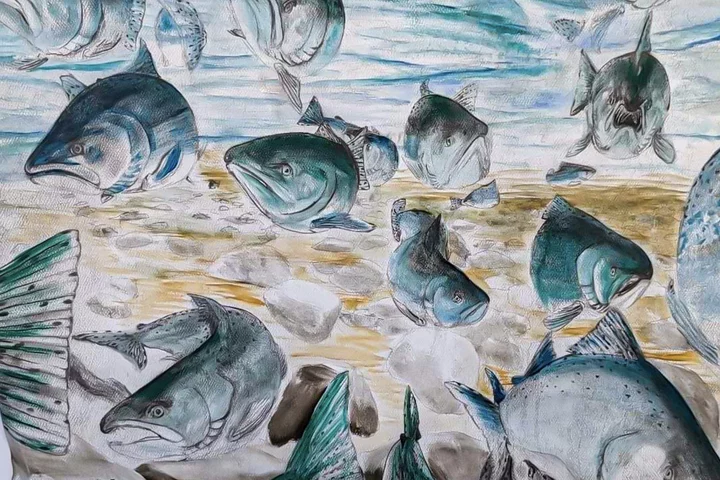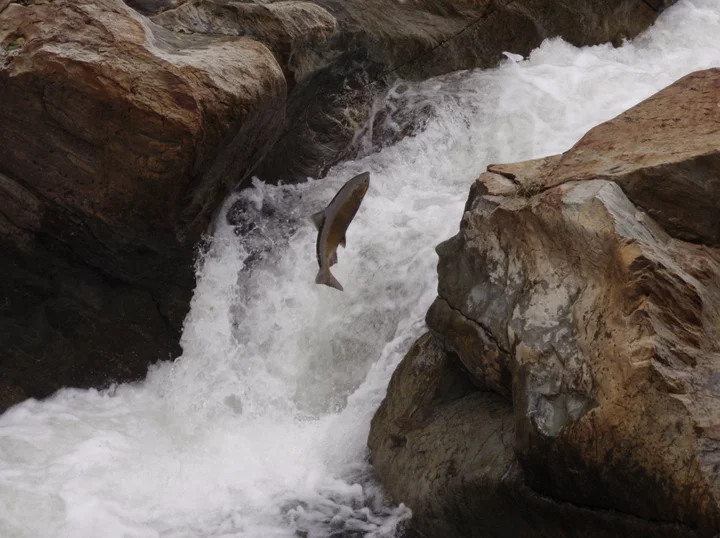Klamath Dam Removal Project On Track to Open 420 Miles of Salmon Habitat This Fall
LoCO Staff / Tuesday, July 23, 2024 @ 11:11 a.m. / Infrastructure
National Oceanic and Atmospheric Administration release:
Demolition of Copco No. 1 Dam (Credit: Whitney Hassett/Swiftwater Films)
For the first time since 1918, an astonishing 420 miles of salmon habitat in the Klamath River watershed in California and Oregon will be fully connected by September. This results from the world’s largest dam removal effort, the Klamath River Renewal Project. The amount of habitat opened up on the Klamath is equivalent to the distance between Portland, Maine, and Philadelphia–a journey through seven states.
PacifiCorp, the previous owner, agreed to remove the aging dams after they determined removal would be less expensive than upgrading to current environmental standards. The dams had been used for power generation, not water storage. The Copco No. 2 Dam on the Klamath was removed last year. The deconstruction of the Iron Gate, Copco No. 1, and JC Boyle dams is underway and running ahead of schedule.
“I think in September, we may have some Chinook salmon and steelhead moseying upstream and checking things out for the first time in over 60 years,” says Bob Pagliuco, NOAA marine habitat resource specialist. “Based on what I’ve seen and what I know these fish can do, I think they will start occupying these habitats immediately. There won’t be any great numbers at first, but within several generations—10 to 15 years—new populations will be established.”
There’s more good news for Klamath salmon and steelhead. NOAA’s Office of Habitat Conservation recommends an $18 million award to the Yurok Tribe to restore and reconnect cold-water tributaries that will be open to migratory fish after dam removal. Another roughly $1.9 million award is recommended to the Oregon Department of Fish and Wildlife to begin evaluating options for improving fish passage at Keno Dam. The Keno Dam sits upstream of the dams currently being removed. Nearly 350 miles of additional salmon habitat lie upstream. Both awards are funded through the Bipartisan Infrastructure Law and Inflation Reduction Act.
“The Yurok people are extremely happy to be witnessing the beginning of the Klamath River’s rebirth,” says Yurok Tribe Fisheries Department Director Barry McCovey. “The dams caused a tremendous amount of damage to the Klamath over the last century. Through the decommissioning project and holistic restoration, we are confident that we will see the Klamath’s salmon, steelhead, and Pacific lamprey runs recover.”
A River Reborn
The Klamath River once produced the third-largest run of salmon in the lower 48 states. It was the lifeblood of tribes throughout the region and supported important commercial and recreational fisheries. However, major dam construction between 1918 and 1966 and other development cut off the upstream pathway for migrating salmon. Tribes and other community members who depended on salmon fisheries lost this critical cultural and subsistence resource.
In 2002, an estimated 30,000–70,000 fish perished in the Klamath River below the dams, partially due to low flows being released from the Iron Gate Dam. Following this event, the Yurok Tribe launched an investigation and, together with other tribes, called for removal of the dams. Since then, NOAA and other federal, state, and local agencies as well as nonprofits and other groups have joined the effort. The Klamath River Renewal Corporation took over ownership of four dams from PacifiCorp, and is overseeing the removal process.
Map of the Klamath River watershed showing the four dams being removed as part of the Klamath Renewal Project as well the upstream Keno and Link River dams | Klamath River Renewal Corporation
In April, NOAA scientists, restoration specialists, and the head of NOAA Fisheries, Janet Coit, gathered on a slope above the Klamath River to watch it being reborn. Over the winter, crews had breached three of the remaining major dams blocking the river’s natural flow, draining the reservoirs behind them. The river found its historical channel for the first time in more than a century, a crucial step in preparing the habitat for the return of salmon.
“Many of our colleagues have spent more than 20 years working towards this moment,” says NOAA Fish Biologist Shari Witmore. “Watching the recovery and how quickly it’s happening has been impressive and emotional for us all.”
In the long term, dam removal will significantly improve water quality in the Klamath. “Algae problems in the reservoirs behind the dams were so bad that the water was dangerous for contact during the summertime, meaning it was not safe for you and your dog to swim in and not drinkable,” says Fluvial Geomorphologist Brian Cluer. “Taking these large reservoirs out gives the river water a chance to aerate, increasing oxygen levels and reducing algae production.” It will also reduce water temperatures and the risk of salmon-killing disease outbreaks.
Plants sprouting from the reservoir footprint on the Klamath (Credit: Tommy Williams/NOAA)
Helping Salmon Adapt to Climate Change
Reconnecting the river will help salmon and steelhead populations survive a warming climate and disasters like forest fires and droughts. Migrating adults will be able to reach spawning grounds in tributaries with cold-water springs, increasing the survival rate of juveniles. With access to more habitat, fish can distribute across the landscape within the Klamath Basin. “If a forest fire impacts a specific river reach or tributary, individuals or populations elsewhere in the Basin can still support fish from that same cohort, year class, or life stage,” says NOAA Research Fisheries Biologist Tommy Williams. “Fish from other tributaries or mainstem areas are available to sustain the Basin’s populations as a whole.”
The window for migration will also widen. “There are probably going to be fish moving back and forth 365 days a year,” says Williams. “This expanded migration period helps the population because the freshwater and marine environment are dynamic and variable. If conditions are less than favorable at a specific time or location, fish migrating throughout an expanded migration window are more likely to find favorable conditions.”
Providing access to what historically was a more complex, dynamic ecosystem strengthens their ability to adapt to challenges. “When you simplify the habitat as we did with the dams, salmon can’t express the full range of their life-history diversity,” says Williams. “The Klamath watershed is very prone to disturbance. The environment throughout the historical range of Pacific salmon and steelhead is very dynamic. We have fires, floods, earthquakes, you name it. These fish not only deal with it well, it’s required for their survival by allowing the expression of the full range of their diversity. It challenges them. Through this, they develop this capacity to deal with environmental changes.”
Painting of salmon migrating up the Klamath by Mt. Adams Institute Veteran Intern Evan Daley. The Mt. Adams Institute Veteran Intern program is funded by NOAA.
The Return of Salmon
NOAA scientists expect small numbers of salmon will begin swimming upstream following the removal of dams this fall. But, it will take years before sizable populations return. Salmon and steelhead have 3- to 5-year life cycles, so fish born in the river won’t return for several years.
“For most of these species, it’s going to take four or five generations—12 to 25 years—before we see established populations upriver,” says Williams. “And that’s contingent on many other things like ocean conditions, droughts, and fires. A lesson from the Elwha River dam removals was that the response time varies among species and perhaps for populations in specific locations within a large river basin. In the Klamath Basin we will very likely also observe differences among species and perhaps among populations within species in the time it takes to establish populations.”
However, repopulation may occur more quickly than the 12–25 years it could take for these species to reestablish in the Klamath basin. “We’re 10 years past the removal of major dams on Elwha River in Washington, which was blocked for more than 100 years,” says Williams. “It’s now seeing large numbers of fall Chinook salmon. That’s two and a half generations. This gives us confidence in what these fish can do.”
Models predict that as many as 80 percent more Chinook salmon could return to the Klamath basin within 30 years–six to 10 fish generations. Ocean harvest could increase by as much as 46 percent.
The California and Oregon departments of fish and wildlife expect most fish populations will naturally repopulate the watershed. Stray salmon will lead the way. Salmon and steelhead typically return to the streams where they were born to reproduce. However, a growing body of evidence shows that both adult and juvenile fish occasionally stray from their natal habitat to explore new areas. This type of dispersal is well suited for the dynamic environment where salmon are found.
Salmon migrating upstream (Credit: Mid-Klamath Watershed Council)
The straying of some fish helps a population’s genetic legacy outlast disturbances in the stream where they were born. “If you have a few individuals in a population who don’t return home and something happens—Mt. St. Helens erupts and fills the Toutle River with large flows of sediment, killing the fish there—the strays live on,” says Williams. “It’s more or less genetically and demographically beneficial for fish to have this capacity, so if the population gets knocked down, its legacy has a chance to return. In addition, dispersal of fish from other watersheds will find their way into streams and rivers like what happened in the Toutle River.”
Williams expects that after the dam removals, a few fish will disperse upstream and find historical spawning areas. Some of their offspring will return to those streams, and others will find different streams nearby. Slowly, populations will expand across the landscape.
NOAA’s state and tribal partners will conduct extensive monitoring to understand how fish use and repopulate the newly opened habitat. Partners are planning to monitor the effectiveness of the dam removal project using a sonar camera and in-river sampling. This will determine the number and species of fish that are passing by the former Iron Gate Dam site. The project team will also radio tag a subset of these fish and track their journey as they reoccupy new habitat. NOAA will use this information to evaluate the effectiveness of restoration investments, and manage commercial, sport, and tribal fisheries.
Keno Dam on the Klamath River in Oregon located at river mile 236.4. (Credit: Mark Hereford/ODFW)
What’s Next: Reservoir Reach and Fish Passage at Keno Dam
Once the dams come down, NOAA and its partners will begin restoring the Reservoir Reach. That’s the mainstem river and tributaries between the site of the Iron Gate Dam and Link River Dam. “Dam removal is a huge first step, but we’re not done yet,” says Pagliuco. “We need to continue to restore this area to give salmon the best chance to recover.”
In 2022, NOAA, Trout Unlimited, and the Pacific State’s Marine Fisheries Commission released a Reservoir Reach restoration plan that detailed 200 projects to improve salmon habitat. NOAA recently recommended $20 million in funding to address major priorities identified in the plan.
The Yurok Tribe will design and implement habitat restoration in several priority tributaries in the Upper Klamath Basin with an $18 million award. They will:
- Restore up to 140 acres of floodplain habitat
- Reopen 16 miles of stream habitat
- Construct 20 acres of instream habitat features such as logjams and spawning gravels
The Yurok Tribe and NOAA, in collaboration with other tribes and nonprofits, will identify high-priority sites through the planning and design process.
The Oregon Department of Fish and Wildlife is exploring fish passage options at Keno Dam with a recently recommended $1.9 million NOAA award. The Keno Dam sits between the soon-to-be removed JC Boyle Dam and Link River Dam, the most upstream dam on the river.
“The fish ladder on the Keno Dam was not designed to pass anadromous fish,” says Williams. “It was built after two downstream dams were in place when salmon were already blocked from migrating upstream.” When the three downstream dams come down this fall, migratory fish will finally be able to reach the Keno Dam. But, they might have difficulty finding the fish ladder or passing this structure that anadromous salmon and steelhead have never tested.”
Alternatives for fish passage range from building a salmon-friendly fish ladder to completing dam removal. Designs would need to both provide fish passage and retain irrigation and other functions for the surrounding community. Over the next 3 years, the Oregon Department of Fish and Wildlife and its partners will:
- Identify fish passage options in coordination with partners, tribes, and community members
- Study the feasibility of the most viable fish passage options
- Develop cost estimates
- Create a 30-percent engineering design for the chosen option
The Klamath Tribe’s ancestors subsisted on salmon for millennia before the dams were built. Tribe members will play a key role in developing and evaluating fish passage options.
Additional partners include:
- Shasta Indian Nation
- Modoc Nation
- Karuk Tribe
- Ridges to Riffles Indigenous Conservation Group
- Trout Unlimited
- Klamath Water Users Association
Together, this $20 million investment will be truly transformational. It will begin to reverse decades of habitat degradation, allow threatened salmon species to be resilient in the face of climate change, and restore tribal connections to their traditional food source.
BOOKED
Yesterday: 8 felonies, 6 misdemeanors, 0 infractions
JUDGED
Humboldt County Superior Court Calendar: Friday, Jan. 2
CHP REPORTS
Sr36 / Alderpoint Rd (HM office): Traffic Hazard
1050 Mm96 W Hum R10.50 (HM office): Traffic Hazard
ELSEWHERE
RHBB: Driver Trapped After Seizure Reportedly Leads to Crash at Fourth and I Streets in Eureka
Mad River Union: APD: Arcata declares State of Emergency
Hill Fire Grows to 7,074 Acres, 8% Containment; Fire Activity Expected to Increase with Drier, Hotter Conditions
Isabella Vanderheiden / Tuesday, July 23, 2024 @ 10:36 a.m. / Fire
###
As of Tuesday morning, the Hill Fire burning 11 miles south of Willow Creek is listed at 7,074 acres with eight percent containment.
Favorable weather patterns earlier this week helped fire crews “gain good positioning” on the fire and expand containment lines, according to the Hill Fire Incident Command team. However, fire activity is expected to increase over the coming days with rising temperatures and lower relative humidity.
“Crews will be monitoring the west side and patrolling for any hot spots,” according to this morning’s update. “On the east side, crews will focus on suppressing any remaining hot spots as well as continued tactical firing operations. … Structure defense teams remain active to identify potential risks and implement mitigation strategies as part of the larger contingency plan.”
Residents in zones HUM-E076-A, HUM-E077-A, HUM-E077-B and HUM-E077-C are still under an evacuation order. Residents currently under an Evacuation warning should be ready to leave at a moment’s notice if conditions deteriorate. Find your evacuation zone at this link.
The Incident Command team will host a community meeting on Wednesday at 7 p.m. at the Willow Creek Bible Church. The meeting will be streamed live on the 2024 Hill Fire Facebook Page.
The following additional information comes from the Hill Fire Incident Command Team:
CURRENT SITUATION:
Favorable weather patterns during the early part of the week allowed firefighters to gain good positioning on the Hill Fire and increase containment to 8%. Tactical firing along Forest Road 6N06 on the eastern boundary of the fire has enabled crews to create as much as 200 feet of depth between the fireline and the primary fire expanding the fire footprint 7074 acres. This strategic approach continued with unmanned aircraft assisting in the evening, further extending the depth.
Crews have successfully connected these firing operations with a combination of dozer and hand lines connecting to Mosquito Creek and the western edge of the fire. Mop-up operations were continued to address remaining hotspots along the fire’s perimeter. Control lines in the north and west continued to be monitored, and hotspots eliminated overnight.
Map of Hill Fire Boundaries. Click to enlarge.
With rising temperatures and lower relative humidity expected during the next few days, these proactive operations have positioned crews ahead of the weather change. Structure defense teams remain active to identify potential risks and implement mitigation strategies as part of the larger contingency plan.
Today, with the drier weather and hotter temperatures, fire activity is expected to increase, allowing for the ignition of some areas within the fire perimeter that still have unburned fuel. Crews will be monitoring the west side and patrolling for any hot spots. On the east side, crews will focus on suppressing any remaining hot spots as well as continued tactical firing operations.
WEATHER:
High pressure will peak today with heat approaching 100 and relative humidity near 20 percent in clear valley. Smoke, especially on the east side will generally moderate conditions, but still expect to be hotter and drier than yesterday. Increased lift will help disperse smoke but weak and battling winds switching from south to north will not be favorable to efficient smoke transport. Compressing inversion will bring poorer overnight recoveries to mid-elevations. Despite high pressure at the surface, instability and moisture aloft will bring a slight chance of dry thunderstorms by early Wednesday morning.
EVACUATIONS:
Evacuation order and warnings remain in effect. For current updates on evacuations, visit https://www.facebook.com/HumboldtSheriff and https://humboldtgov.org/2383/Current-Emergencies.
Conditions are subject to change at any time, visit https://protect.genasys.com/search for a full zone description. Sign up for Humboldt Alert emergency notifications at https://humboldtgov.org/2014/Emergency-Notifications
CLOSURES:
Forest Closure Order currently in effect for the area impacted by the Hill Fire. It is temporarily prohibited to be on any national forest system land, trail, or road within the closure area. To view the closure order and map of closure area visit the following link www.fs.usda.gov/Internet/FSE_DOCUMENTS/fseprd1191963.pdf.
Road closures are currently in place on Friday Ridge Rd. at Forest Service Route 6N06, Friday Ridge Rd. at Forest Route 5N01 and Friday Fridge Rd. at Forest Route 5N04. For updated road closure information, visit protect.genasys.com or humboldtsheriff.org/emergency.
FIRE RESTRICTIONS:
Forest fire restrictions also went into effect on July 12th . Campfires and stove fires are restricted to those developed areas listed in the forest order located at https://www.fs.usda.gov/Internet/FSE_DOCUMENTS/fseprd1188610.pdf.
Smoking, welding, and operating an internal combustion engine also have restrictions in place
###
With Jacobs Property Deal Still Shrouded in Secrecy, League of Women Voters Urges Public to Attend the Next Eureka City Schools Board Meeting
LoCO Staff / Tuesday, July 23, 2024 @ 8:03 a.m. / Government
The Jacobs campus. | File photo.
###
From the League of Women Voters of Humboldt County:
On June 25th and 27th, The League of Women Voters of Humboldt County (LWVHC) read statements to the Eureka City Schools Board of Trustees regarding the property transaction between Eureka City Schools and AMG Communities - Jacobs, LLC pertaining to 674 Allard Avenue (Former Jacobs Middle School) and 3553 | Street, Eureka.
The LWVHC feels very strongly about the need for full and open transparency related to the actions of elected governmental boards and governmental decision-making.
At both Board meetings, we expressed our concern about the lack of transparency concerning the details of the transaction and the names of the members of the newly-formed LLC, as well as the minimal public notification or community input. We also urged that the Board delay the close of escrow on that transaction.
We applaud the Eureka City Schools Board of Trustees for delaying the close of escrow until August 9, 2024. However, the names of the members of AMG Communities - Jacobs, LLC still have NOT been disclosed.
Therefore, we urge concerned community members to attend the next Eureka City Schools Board of Trustees meeting on August 8, 2024 to voice their opinions and concerns. The agenda for the meeting is not yet available on the Eureka City Schools website, but we hope it will be available at least 24 hours prior to the Board meeting.
Community members can also contact Eureka City Schools to request a digital copy of the agenda prior to the meeting. The regular session Board meeting will take place at 2100 J Street in Eureka and will begin at 6:30pm.
The League of Women Voters is a nonpartisan political organization. We are nonpartisan in that we do not support or oppose any political party or candidate; we are political in that we take positions on selected governmental issues after member study and consensus.
Respectfully submitted,
Julie Kelly,
League of Women Voters of Humboldt County, President
and the Board of Directors, League of Women Voters of Humboldt County
###
PREVIOUSLY: League of Women Voters Chimes in on Lack of Transparency in Eureka City Schools Property Transfer
In case you’ve been wondering where the Jacobs campus is, here’s a map.
OBITUARY: Robert Cogen, 1935-2024
LoCO Staff / Tuesday, July 23, 2024 @ 6:45 a.m. / Obits
It is with great sadness that we announce the passing of Robert Sklar
Cogen, 89, on the morning of May 28, 2024. He died from the effects of the
devastating stroke he suffered many years ago. With great determination,
he fought until the end to regain what he had lost and continued to make
the most of what he had. Robert had a long life of adventuring, creating and
helping others, but the baling wire and duct tape could not hold him
together any longer.
He was many things in his long life: herpetologist, lawyer, artist, kinetic pilot, writer, gourmet, naturalist, overall scientist, poet, scuba diver, tour guide and educator. Robert lived life to the fullest.
For those of us who were family, he leaves a hole that cannot be filled. We honor his memory by living our lives with joy and a spirit of adventure.
Robert is survived by his wife Christine (Curtis), his daughter Amy Berkowitz and her husband Cliff, daughter Karen North, grandsons Alexander Berkowitz, Michael Berkowitz, Brian North, and granddaughter Mallory North. Also sisters-in-law Kimberly Swan, Deborah Schwartz Lipke (Randy), Lindarose Bruce (James), Terri Douglas (Ross), niece Jessica Swan-Purchio (Cameron) and many other nieces and nephews.
Robert was predeceased by his parents Harry and Dena Cogen, his sister Suzanne Cogen and close friends David Walker and Peter Presnell. Our deepest gratitude to Frye’s Care Home, Redwood Coast PACE, and Hospice of Humboldt for their exceptional and thoughtful care; and to his faithful friend, John Porter, who brought so much happiness to Robert at their Monday evening get togethers.
###
The obituary above was submitted on behalf of Robert’s loved ones. The Lost Coast Outpost runs obituaries of Humboldt County residents at no charge. See guidelines here.
OBITUARY: Walter Cosce, 1946-2024
LoCO Staff / Tuesday, July 23, 2024 @ 6:45 a.m. / Obits
Walter Louis Cosce, Sr., was born on July 19, 1946, in San Francisco, CA, to Italo and Marietta Cosce. He began his journey home on July 13, 2024, six days shy of his 78th birthday.
Walt was a veteran of the US Navy, having served aboard several aircraft carriers during the Vietnam War. He was proud of having served his country and was an active member of American Legion Post 415 in Hoopa.
Walt came to Weitchpec in the late 1960s. Like so many others, he was drawn by the prospect of finding gold. He always said he found his gold in the land and the people here. He often told the story of turning to his buddy and saying, “Wouldn’t you just love to tell people you live in Weitchpec?” He loved it so much that he did it for the rest of his life.
Walt held several occupations in his time, but logging got into his bones. He was in his happy place anytime he had a chainsaw in his hands. When logging jobs became scarce, he turned to cutting firewood, keeping his friends and neighbors warm as well as donating countless cords to fundraisers for local youth. He could recall a wealth of local history, family lore, and off-color jokes. Walt was an avid fisherman, an excellent cook, a master gardener, a great pool player, a pretty fair shade tree mechanic, and the perfect Santa Claus. However, his absolute favorite thing to do was to help people. He was the guy who had the tools, know-how, and willingness to help anyone, anywhere, anytime. Even when he couldn’t fix the problem, you’d walk away smiling because the man would say anything for a laugh. ANYTHING.
Walt is preceded in death by his parents, Italo and Marietta Cosce; his son, Jason Price Sr.; and his grandsons Jason Price Jr. and William Price. He is survived by his sisters, Barbara Mylin (Rich) and Emmy Cosce; brothers Leo Cosce (Joanne) and Albert Cosce (Beverly); his wife, Sunny Cosce; sons Walter (Louie) Cosce Jr., Vito Cosce (Ashley), and Chad “Mugzy” Sanders (Kira); his daughters Lena Cosce (Larry) and Taura Cosce (Tanner); daughter-in-law Sarah Scott (Alex); grandsons Roman Price, Miles Barner, Orion Cosce (Liana), Louis Cosce (Bri), Shawn MacMurray Jr., Italo and Leo Cosce, and Joey Schaeffer; granddaughters Devin, Jaycee, Crystal, and Kaylee Price, Aeriana Cosce, Yvonne Cosce, Julie-sa Harrison-Cosce, Marina Cosce, Felicia and Autumn Arambula (Seth), Uonascha Parker (Damani), Lorita Schaeffer, and Luella Cosce; great-grandchildren Steven Watson, Jase Price-Lewis, Domanik and Vienna Cosce, and Tia Cosce; as well as numerous nieces and nephews. He also leaves behind the Crayton family, Chris Hoyas, Kim Conrad, Windy Thornton and family, and too many other special friends to mention, all of whom he considered family.
A celebration of life for Walt will be held on August 3 at 12:00 p.m. at the Libby Nix Community Center in Weitchpec. Please bring a potluck dish and your favorite Walt Cosce stories to share.
Happy trails, Doc…until we meet again, “Peace, love, and all that hippie shit.”
###
The obituary above was submitted on behalf of Walt’s loved ones. The Lost Coast Outpost runs obituaries of Humboldt County residents at no charge. See guidelines here.
OBITUARY: Mary Kempton, 1932-2024
LoCO Staff / Tuesday, July 23, 2024 @ 6:45 a.m. / Obits
Mary Bell (Sivils) Kempton, aged 91, passed away on May 9, 2024, in Eureka, CA, surrounded by her loving family. Born on June 10, 1932, in Sasakwa, Oklahoma, Mary was the cherished daughter of William and Willa Sivils. At the age of 2, she moved with her family to Arlington, Kansas, where she was raised and later graduated from Arlington High School in 1950.
Mary was known for her radiant smile and the warmth she brought into every room. A devoted wife, mother, grandmother, great-grandmother, and sister, Mary placed her family at the center of her life, loving them deeply and unconditionally. She was the matriarch and the steady rock that everyone relied on. Her culinary skills were a major part of family gatherings, with her handwritten recipes and the cherished cookbook from her high school graduation being prized family possessions. Though many have tried, no one could replicate her dishes quite like she could.
Mary was the only one among her seven siblings to venture far from the Midwest, yet maintained close bonds with them despite the distance. Her life with her husband, Fred Kempton, whom she was married to for 71 years, was filled with love and shared adventures, including numerous road trips with her siblings and memorable annual summer trips to Kansas.
Mary is survived by her loving husband, Fred Kempton; her children, William Kempton (Tina), Susan Johnson (Leonard), and Amy Kempton; grandchildren, Treggan Mullenix (Betty), Laura Sarvinski (Travis), Neil Johnson, Jason Schoenmehl, and Tiffany Chappelle, (Luke) ; great-grandchildren William and Shawn Chappelle, Olivia and Jett Sarvinski, and Luka Mullenix; her brother Kenneth Sivils; and many nieces and nephews.
Mary was preceded in death by her parents, William and Willa Sivils; her daughter, Laura Chappelle; her grandson, Matthew Chappelle; and her siblings, Wilena Lander, Donna Kaufman, Lois Guthrie, Cleo Oliphant, and Arnold Sivils.
Mary’s life was a beautiful testament to the power of love and family, and she will be profoundly missed by all who knew her.
###
The obituary above was submitted on behalf of Mary’s loved ones. The Lost Coast Outpost runs obituaries of Humboldt County residents at no charge. See guidelines here.
OBITUARY: Carol Colby, 1960-2024
LoCO Staff / Tuesday, July 23, 2024 @ 6:45 a.m. / Obits
Carol Beth Colby was born on August 4, 1960, in Oxnard, California, to Gerald Arley Colby and Sylvia Lorraine Colby. She passed away on April 25, 2024.
Carol spent her early childhood in Oxnard, California, and moved to Eureka, CA, in 1972 with her mother, father, and three sisters. It was in Eureka where Carol developed a love for golf, just like her father, Jerry Colby. She frequented Eureka Municipal Golf Course and occasionally played at Baywood Golf and Country Club. Carol enjoyed the camaraderie of many golfing friends, especially the ladies’ golf group, including her favorite golf partner, Donna Hunter.
Carol worked for many years in the automotive industry, including mechanics and wholesale warehouse services in Eureka, with her last job at Napa Automotive Parts in downtown Eureka. She attended Eureka High School and was also a member of the United States Air Force.
Carol was blessed with the birth of her son, Jerry Lee Colby (Kitsu), and raised her family in Eureka. She was especially proud of her son’s recently opened business, “Sparky Fox Arcade,” at the Bayshore Mall. She would tell anyone who would listen how proud she was of Kitsu’s accomplishment.
Carol is survived by her son Kitsu Colby and Damien King, and her sisters Lynn Niekrasz (husband Michael) and Ann Colby. She is also survived by her niece Rachel Rudd and nephews Jason Garza, Christopher Garza, Josh Mann, Keith Mann, and Jesse Alora. Carol was preceded in death by her parents, Jerry Colby and Sylvia Scott, and her elder sister Jeri Garza. Also beloved son-in-law Alex Hanover.
A “Celebration of Life” will be held on Carol’s birthday, August 4th, from 1-3 pm at Synapsis performance space, 1675 Union St., Eureka.
###
The obituary above was submitted on behalf of Carol’s loved ones. The Lost Coast Outpost runs obituaries of Humboldt County residents at no charge. See guidelines here.

















